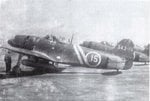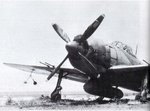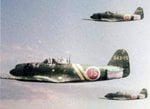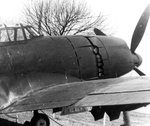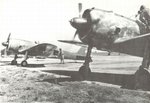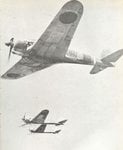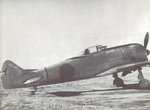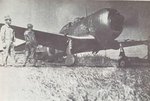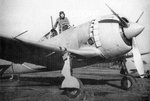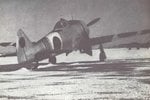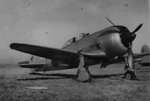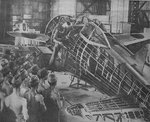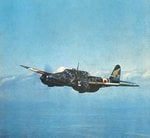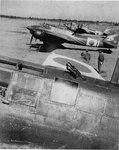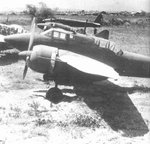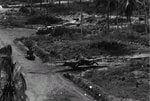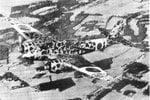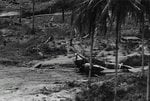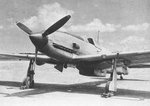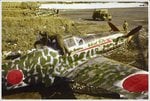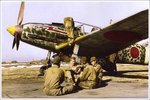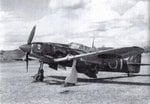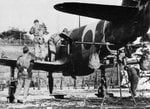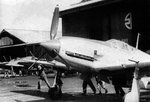- Thread starter
- #21
In December of 1941, the Kawanishi engineering team proposed to their management that it might be a good idea to produce a land-based version of the company's N1K1 Kyofu seaplane fighter. Kawanishi management thought enough of the idea that they decided to go ahead with the project as a private venture. Initially, few changes over the N1K1 were planned other than the replacement of the floats with retractable land undercarriage. However it was decided to replace the 14-cylinder Kasei engine with an eighteen-cylinder Nakajima Homare air-cooled radial which, it was hoped, would deliver 2000 hp. To take advantage of the increased power, a new four-bladed propeller with a diameter of 10 feet 10 inches was to be fitted. However, since the original mid-wing configuration of the Kyofu was retained, a very stalky undercarriage was required in order that the prop be able to clear the ground. This in turn required a rather complex scheme of double landing gear retraction, in which the legs contracted as they folded into the wing wells. The aft portion of the fuselage was deepened to give more vertical stabilizing area and included a retractable tailwheel. A unique feature of the N1K1-J was its set of combat flaps. Whereas flap extension was manually controlled on the Kyofu seaplane, the flaps on the landplane version had the ability automatically to change their angle in response to changes in g-forces during manoeuvres. This automatic operation freed up the pilot from having to worry about his flaps during combat, and eliminated the possibility of a stall at an inopportune time. The land based fighter made its maiden flight on December 27, 1942. Since the aircraft was a private venture, it had no military designation, and was known as the Model X-1 experimental land based fighter by the manufacturer. The engine was the 1820 hp Nakajima Homare 11 radial. It was armed with two 7.7 mm Type 97 machine guns in the fuselage and two 20-mm Type 99 Model 2 cannon housed in underwing gondolas. Since the Homare 11 had been accepted for production before the completion of its final tests, it was plagued with teething troubles. The early Homare engine failed to develop its rated power, the propeller torque during takeoff was excessive, and the visibility during taxiing was poor. However the aircraft had pleasant flying characteristics and the automatic combat flaps gave the aircraft exceptional manoeuvrability.
By July of 1943, four prototypes had been built, and one was handed over to the Navy for trials. The performance was disappointing, the maximum speed being only 357 mph (403 mph had been promised). However, it was faster than the Mitsubishi A6M5 Reisen and was more manoeuvrable and longer-ranged than the faster Mitsubishi J2M2 Raiden. By this time, the Japanese Navy was in desperate need of fighters capable of countering the Vought F4U Corsair and the Grumman F6F Hellcat, and gave authorization for Kawanishi to proceed with further development of the land-based version of the Kyofu under the designation N1K1-J Shiden (Violet Lightning) Interceptor Fighter. The J indicated that it was a landplane development of the original N1K1. Further prototypes and service trial aircraft were built during 1943. They were fitted with the more powerful 1990 hp Nakajima NK9H Homare 21 radial. The cowling was modified and featured an additional lower lip scoop. Individual exhaust stacks were fitted, and an external oil cooler was mounted on the port side of the cowling behind and below the cooling gills. Two additional 20-mm Type 99 Model 2 cannon were installed in the wings just outboard of the external underwing cannon gondolas.
Quantity production was ordered by the Navy as the Navy Interceptor Fighter Shiden Model 11. By the end of 1943, 70 aircraft had been built at the Naruo Works, and the first aircraft had been delivered by the Kawanishi plant at Himeji. The N1K1-J entered service with land-based squadrons of the Japanese Navy early in 1944. Armament consisted of 2 7.7-mm machine guns in the fuselage and four 20 mm cannon in the wings (2 in the wing, 2 in underwing gondolas). The first large unit of Shidens to be deployed was the 341st Kokutai (Air Corps), which was transferred to Luzon from Formosa on October 20, 1944. The N1K1-J was first encountered by American forces in combat over Formosa and the Philippines. It was assigned the Allied code name George. It quickly established itself as one of the toughest and most troublesome Japanese fighters yet to be met in combat. It was a truly exceptional combat aircraft in the hands of an experienced pilot. It proved itself superior to most US shipboard fighters that it encountered, and many experienced Shiden pilots regarded the previously-formidable Grumman F6F Hellcat as a particularly easy "kill".
By July of 1943, four prototypes had been built, and one was handed over to the Navy for trials. The performance was disappointing, the maximum speed being only 357 mph (403 mph had been promised). However, it was faster than the Mitsubishi A6M5 Reisen and was more manoeuvrable and longer-ranged than the faster Mitsubishi J2M2 Raiden. By this time, the Japanese Navy was in desperate need of fighters capable of countering the Vought F4U Corsair and the Grumman F6F Hellcat, and gave authorization for Kawanishi to proceed with further development of the land-based version of the Kyofu under the designation N1K1-J Shiden (Violet Lightning) Interceptor Fighter. The J indicated that it was a landplane development of the original N1K1. Further prototypes and service trial aircraft were built during 1943. They were fitted with the more powerful 1990 hp Nakajima NK9H Homare 21 radial. The cowling was modified and featured an additional lower lip scoop. Individual exhaust stacks were fitted, and an external oil cooler was mounted on the port side of the cowling behind and below the cooling gills. Two additional 20-mm Type 99 Model 2 cannon were installed in the wings just outboard of the external underwing cannon gondolas.
Quantity production was ordered by the Navy as the Navy Interceptor Fighter Shiden Model 11. By the end of 1943, 70 aircraft had been built at the Naruo Works, and the first aircraft had been delivered by the Kawanishi plant at Himeji. The N1K1-J entered service with land-based squadrons of the Japanese Navy early in 1944. Armament consisted of 2 7.7-mm machine guns in the fuselage and four 20 mm cannon in the wings (2 in the wing, 2 in underwing gondolas). The first large unit of Shidens to be deployed was the 341st Kokutai (Air Corps), which was transferred to Luzon from Formosa on October 20, 1944. The N1K1-J was first encountered by American forces in combat over Formosa and the Philippines. It was assigned the Allied code name George. It quickly established itself as one of the toughest and most troublesome Japanese fighters yet to be met in combat. It was a truly exceptional combat aircraft in the hands of an experienced pilot. It proved itself superior to most US shipboard fighters that it encountered, and many experienced Shiden pilots regarded the previously-formidable Grumman F6F Hellcat as a particularly easy "kill".
Attachments
-
 Kawanishi N1K1 George 001.jpg90.6 KB · Views: 1,324
Kawanishi N1K1 George 001.jpg90.6 KB · Views: 1,324 -
 Kawanishi N1K1 George 002.jpg97.2 KB · Views: 732
Kawanishi N1K1 George 002.jpg97.2 KB · Views: 732 -
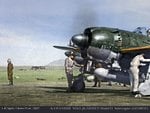 Kawanishi N1K1 George 003.jpg137.7 KB · Views: 1,215
Kawanishi N1K1 George 003.jpg137.7 KB · Views: 1,215 -
 Kawanishi N1K1 George 004.jpg90.9 KB · Views: 686
Kawanishi N1K1 George 004.jpg90.9 KB · Views: 686 -
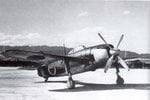 Kawanishi N1K1 George 005.jpg93.8 KB · Views: 553
Kawanishi N1K1 George 005.jpg93.8 KB · Views: 553 -
 Kawanishi N1K1 George 006.jpg90.4 KB · Views: 466
Kawanishi N1K1 George 006.jpg90.4 KB · Views: 466 -
 Kawanishi N1K1 George 007.jpg98.5 KB · Views: 495
Kawanishi N1K1 George 007.jpg98.5 KB · Views: 495 -
 Kawanishi N1K1 George 008.jpg111.9 KB · Views: 556
Kawanishi N1K1 George 008.jpg111.9 KB · Views: 556 -
 Kawanishi N1K1 George 009.jpg100.5 KB · Views: 563
Kawanishi N1K1 George 009.jpg100.5 KB · Views: 563 -
 Kawanishi N1K1 George 0010.jpg94.3 KB · Views: 685
Kawanishi N1K1 George 0010.jpg94.3 KB · Views: 685 -
 Kawanishi N1K1 George 0011.jpg101.6 KB · Views: 723
Kawanishi N1K1 George 0011.jpg101.6 KB · Views: 723


